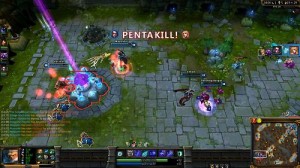
A competitive game that also relies heavily on cooperation can lead to a very hateful community, in the end.
It should come as little surprise, able readers, that any proper game requires a measure of skill. Skill as it relates to gameplay is the only thing preventing a videogame from being a series of interactive menus and visuals, and yet there have been such examples of games (label applied colloquially) that make no bones about being exactly that. Our beloved Ethos has written before about older examples such as Flower, and newer cases can be seen in games like Dear Esther or Gone Home which provide a story that the player need only walk through like a dynamic movie presentation. Aside from outliers like those, and despite their growing prominence, most games still ask for a measure of skill from players. And where most successful games make or break themselves is on how they handle that requirement, especially if the game is meant to be played with multiple people. There are many ways to skin this particular cat, so let us look at some of them and maybe gain a better understanding. I mean about skill in games, not cat skinning. Please do not skin cats.
So with Nintendo back on front pages in many corners of the internet with their DeNA (read as “DNA”, not “dena”) and “NX” announcements, many eyes will be upon their coming moves and keynotes regarding hardware and mobile publication and integration. It would be just as worthy to ponder about how these events will impact Nintendo’s historically checkered past with skill gaps in games as they begin to align themselves more closely with the most causal of gaming markets. The Wii’s contribution to their design philosophy lead Nintendo on a path to widen as many nets as possible by making simpler games, simpler controllers, lower price points, and fewer hurdles between a player and the ending of a game. It was during this time that Nintendo would implement level skipping features that allowed less skilled players to pass content that they struggled on and it was also the time they released Super Smash Bros. Brawl which famously stripped competitive elements from the game to keep less skilled players more in the running with skilled players.

Can’t beat a level? Super Mario 3D World will do most of the heavy lifting with an invincibility power-up.
The idea of it, from a business stand point, makes sense. It aims to get more consumers to buy or be interested in a product and in future products within that series. In practice, this policy proves good for little more than a quick (albeit large) cash injection as it draws in new consumers uninterested in reuptake. While the “core” gamers that have built up skill and interest might number fewer than first time players, they also represent consecutive sales and free publicity. Closing the skill gap in this way also assumes that an unskilled player cannot gain the necessary skills, almost as if one is either born adept at games or not and that it would be somehow untoward to exclude people through no fault of their own. This is simply untrue in every possible way, not the least of which being that skill is gained in the face of requisite challenges. If fewer people require skill, then fewer skills will be gained and games will get easier and easier until all that is left are Flowers and Dear Esthers.
It might seem that gaming is headed that way, but I would disagree. While games have gotten easier, it has less to do with intended skill and more to do with better design. When older games are considered difficult it is usually a product of game-time padding or vestiges of quarter-munching arcades or, worse, just poorly conveyed controls and mechanics. When a particularly difficult game is released today, often words like “fair” are bandied about to differentiate this kind of difficulty from the clunky mechanical difficulty of older titles. “Unforgiving” is a term used to describe older difficulty styles, ones that would require massive time investment by having no or limited saved progress, whereas today a difficult game would ask the player to learn how to overcome an easily repeated challenge that is not gated behind much preamble.
Competitive games not on Nintendo platforms have largely embraced the skill gaps that they naturally develop and ask newcomers to accept that these games will have a punishing, sometimes even humiliating, difficulty curve. The enthusiasm with overcoming steep challenges once found in single player console games is very alive and well in places like competitive PC games of all sorts. From classics like Counterstrike to newer arrivals like League of Legends, PC gaming has been host to some of the greatest challenges in gaming that a player could seek out. Open world affairs that pit players against each other like EVE: Online or the newer Elite: Dangerous also contribute to the choices on hand for those looking to struggle and learn and master a game instead of be handed a victory as an inevitability or an expectation.
But this method has its own pitfalls, usually in the form of over reliance on user agency. When given the choice to win by any means, players in competitive scenarios will do that exactly. It ultimately funnels the game down a few rabbit holes and none of them are very pretty. Either the community gets overwhelmingly toxic (League) and requires measures be taken to save the community from itself or the game slowly breaks down into very conservative collusion (read: boring) aimed at keeping the powerful in power (EVE). It might mimic real life to an interesting degree, but I would rather actually enter into a career in politics instead of earning simulated profits from simulated deal-making.
Now give me your tired huddled masses of comments yearning to be typed, let them spill forth onto the comments section about these differing approaches to skill requirements in gaming. Do you enjoy high-skill competitive titles like the ones I have mentioned or are you more into tailored story-driven experiences? If both, perhaps regale us with why and when you prefer each. Until next week!
